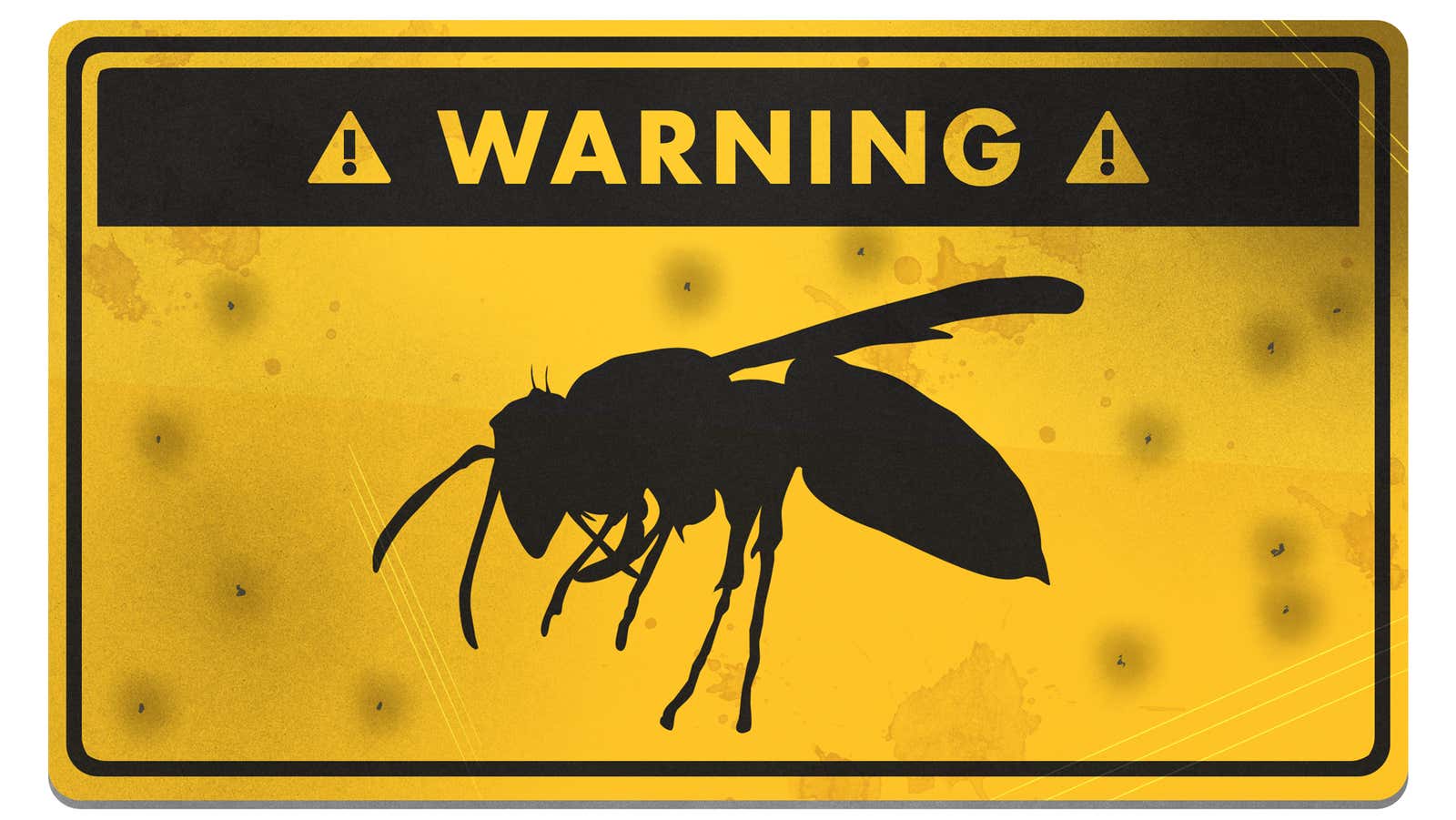How to Survive a Bee, Hornet or Wasp Attack

These buzzing bugs in your backyard are more than a nuisance on your barbecue. In numbers, they pose a serious threat. And if you are one of the many people who are allergic to bees, hornets, and wasps, even some of them can be dangerous. Here’s how to avoid the swarm and what to do if you get stung.
According to Dr. Joseph Forrester , a Stanford University surgeon and co-authorof the2012National Animal Mortality Survey , bees, hornets and wasps are some of the deadliest wildlife you will ever encounter :
“… when you only look at the attacks of wild animals, the most common cause of death is poisonous animals such as wasps or bees. I think people think that the most dangerous animals are cougars, bears or alligators, but the bee is more dangerous if the person is prone to react. “
In fact, among adults 20 and older, hornets, wasps, and bees account for about 33% of all animal-related deaths in the United States, and many are due to allergies. You can usually avoid attacks in the wild simply by staying away from hives and nests . If you leave them alone, they will leave you alone. So try not to disturb them at home.
But if you know you are allergic to bee, hornet or wasp stings, there are a few extra precautions you should take, as just one or two stings could mean game over. Always wear shoes outdoors, avoid brightly colored clothing, avoid sugary lotions, perfumes and shampoos, and wear long-sleeved pants and shirts if possible. And most importantly, carry an adrenaline injection pen that you can use in an emergency.
While avoiding nests in the wild is pretty straightforward, it’s a whole different story when they’re trying to make your home their home. These flying hymenoptera arthropods often like to nest themselves in or around structures, such as under the eaves of your house, in trees and bushes, and even in children’s playgrounds.
Usually, the difference between a bee hive, hornet’s nest or aspen colony can be distinguished by its appearance . The umbrella-shaped nest with hexagonal cells is home to paper wasps, the sleek soccer-ball-shaped nest belongs to hornets, wasps flying into a hole in the ground or in a building are most likely yellow jackets, and if the nest is built with a wax substance, you are almost certainly look at the bee hive. But bee hives can also be inside walls, hollow trees, sheds, or abandoned rodent burrows in the ground.
If you come across any of these nests in your home, consider calling a professional to remove them. There are many sprays and traps on the market, but removing the nests yourself can be dangerous and you won’t be able to get them all without the right tools.
If bees bother you, don’t swat them. And if you are stung, leave this place immediately. Some bees, hornets and wasps secrete an “alarm pheromone” when stinging, which can attract more bees to you. However, if you are surrounded by hornets or wasps, you should be a little more careful. They are more sensitive to movement, so as pest control specialist Simon Bereni explains on Quora, hammering, screaming, or running can make you more dangerous . Unless you’ve destroyed their nest, or something else serious enough to summon a real swarm, you’d better stay calm and walk away slowly with your head down, eyes closed, and your face covered if possible.
If you’ve destroyed a hornet or wasp nest, or more aggressive flying insects such as the so-called “killer bees” swarm or attack, the USDA provides some tips for escape :
- Run away as fast as you can. Don’t stop to help others unless you absolutely don’t need them (such as children or the elderly). Do not stop until you reach a hideout, such as a car or building.
- Don’t jump into the water because the bees will wait for you to get out into the air.
- Pull the shirt over your head as you run to protect your face, mouth, and eyes.
- Don’t hit the bees on the run. They are attracted to movement, and dead bees give off a scent that attracts you more.
- Call 911 to report the attack when you are safe.
Even if you escape the swarm, you will most likely be stung multiple times. Honey bee stings continue to pump venom into the wound as long as it remains in you, so it’s important to remove it as soon as possible. But don’t try to pull them out with tweezers or your fingers, as this will only squeeze more poison into the wound.
Use your fingernails, a dull knife, or the edge of a credit card to scrape the side of the sting off the skin (as shown in the video above). In theory, the average person can withstand about 10 honeybee stings per pound of body weight, which means that an adult can withstand over 1,100 stings . But this is definitely not something you should be checking – not even a little. Even a few bites can be incredibly painful, not to mention death if you’re allergic. However, if you are stung more than 15 times, feel unwell, or even suspect you are allergic, seek immediate medical attention.